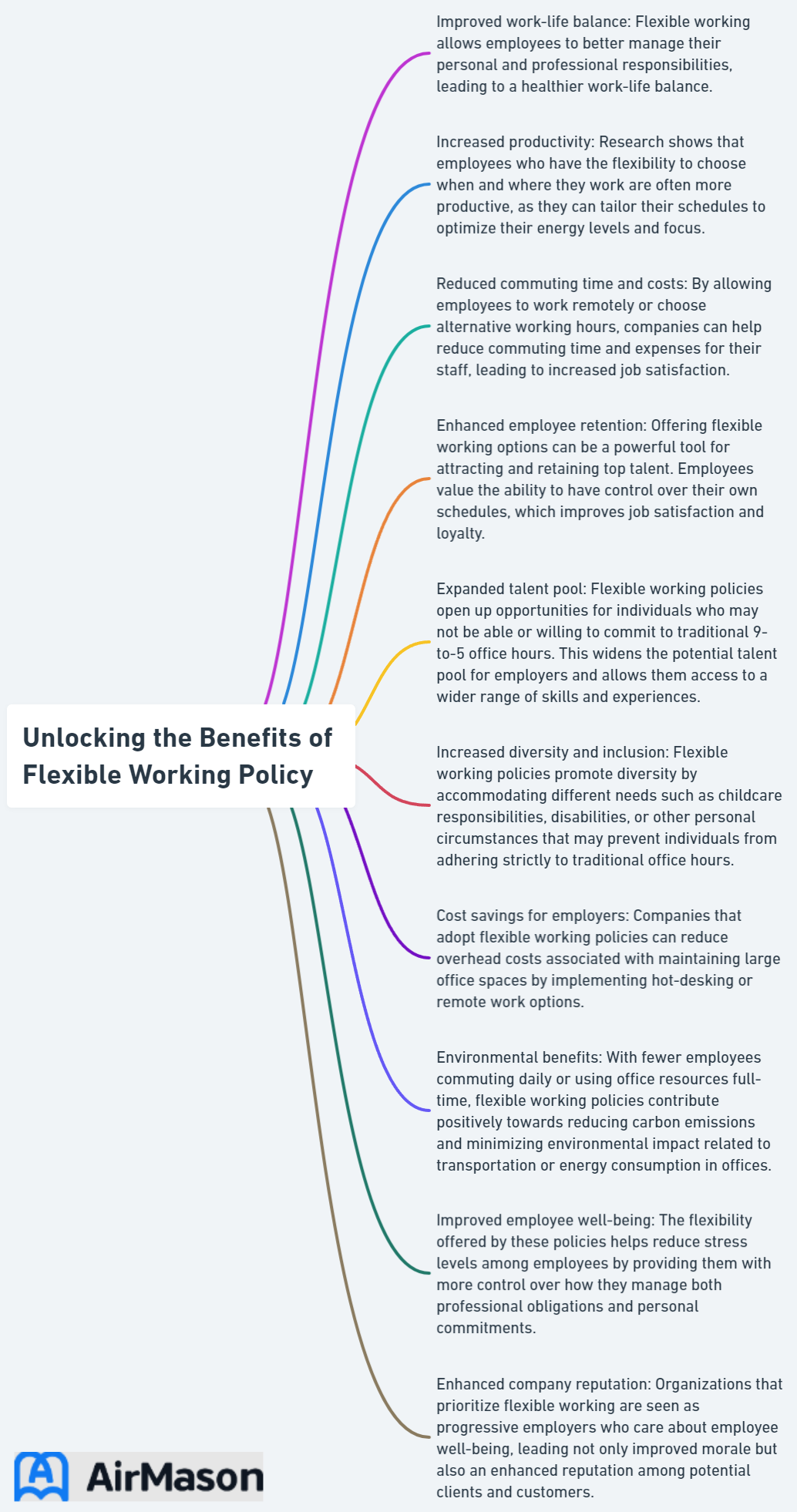
In today’s fast-paced work environment, achieving a harmonious balance between professional and personal life has become increasingly important. A flexible working policy has emerged as a powerful tool that enables employees and organizations alike to adapt and thrive in this dynamic landscape. But how exactly do these policies work, and what are the benefits they offer to both parties? Read on to discover how unlocking the potential of flexible work arrangements can lead to a more engaged and productive workforce.
Key Takeaways
- Flexible working policies promote employee satisfaction, increased retention, and improved performance.
- Organizations must ensure compliance with employment laws and regulations when developing flexible work arrangements that meet the needs of both employees and the organization.
- Flexible working policies positively influence employee engagement and productivity by promoting a better work-life balance & increasing overall efficiency.
Policy for Working Remotely
Our organization recognizes the growing importance of flexibility in the modern work environment, and as such, we have developed a comprehensive Policy for Working Remotely. This policy is designed to provide clear guidelines and expectations for employees engaging in remote work arrangements. We believe that by establishing a structured framework, we can ensure a seamless and productive transition to remote work while maintaining the high standards of performance and collaboration that define our workplace culture. This policy encompasses considerations such as communication protocols, task management, and data security to guarantee a consistent and secure remote work experience for all team members. Emphasizing accountability and open communication, our Policy for Working Remotely aims to create a supportive and efficient remote work environment for our workforce.
Understanding Flexible Working Policies
Flexible work schedule policy has gained significant traction in recent years as organizations recognize the need to accommodate the diverse needs and preferences of their employees. This policy allows employees to modify their work schedules, locations, or arrangements, enabling them to balance their personal and professional lives more effectively.
As a result, companies that adopt flexible working policies can enjoy increased employee satisfaction, higher retention rates, and improved overall performance.

Definition of Flexible Working Policy
A flexible working policy is a set of guidelines that empower employees to adjust their work schedules, locations, or arrangements to better suit their needs and preferences. Typically, an employee would request a flexible work arrangement, and the manager is responsible for determining its feasibility and making the final decision.
Flexible working policies, which grant employees the opportunity to work under conditions that best suit their individual needs, can significantly enhance job satisfaction and foster a more inclusive and supportive work environment. This, in turn, can lead to higher employee engagement and productivity.
Common Types of Flexible Work Arrangements
There are myriad flexible work arrangements available to accommodate the diverse needs of employees, including flexible hours, flexible schedule, and work hours. Some common examples include:
- Flextime
- Compressed workweeks
- Remote work
- Job sharing
- Alternative work schedule
- Flexible work schedule
- Flexible working hours
These arrangements can provide employees with additional personal time, reduce costs associated with childcare and transportation, and offer a more balanced work-life equilibrium.
Employers, however, are obligated to ensure their flexible work policies adhere to all relevant employment laws and regulations and uphold fairness and non-discrimination. By doing so, organizations can create a supportive work environment that benefits both employees and the organization as a whole, as employees work effectively in such conditions.
Developing a Successful Flexible Working Policy

Creating a successful flexible working policy requires a thorough understanding of the organization’s needs and goals, as well as the preferences and requirements of its employees. It is essential to involve all relevant stakeholders, including managers and employees, in the policy development process to ensure its effectiveness and acceptance.
To guarantee a successful implementation of the policy, it is crucial to provide clear guidelines and expectations, monitor and adjust the policy as needed, and address any challenges or concerns that may arise. Let’s delve deeper into the key components involved in developing a successful flexible working policy.
Assessing Organizational Needs

Identifying the specific requirements and goals of the organization and its employees is the first step in determining the most suitable flexible work options. Factors such as the size and industry of the organization, as well as the needs and preferences of the employees, must be taken into account.
Employing methodologies such as surveys, focus groups, and consultations with employees and stakeholders can equip organizations with invaluable insights into their unique needs and objectives. This information can then be used to tailor flexible work arrangements to meet the specific requirements of both the organization and its employees.
Establishing Clear Guidelines
Once the organization’s needs have been assessed, it is essential to establish clear guidelines for the implementation of the flexible working policy. These guidelines should cover the different types of flexible work arrangements available, the eligibility criteria for employees, and any probationary or renewal procedures.
Transparent guidelines enable employees to better understand the expectations and boundaries of the flexible working policy, ensuring a smooth implementation and adherence to the policy. Moreover, it is crucial to train managers to effectively assess and manage flexible work arrangements, considering factors such as the employee’s capabilities and the impact on the department.
Involving Stakeholders
Incorporating stakeholders in the development of a flexible working policy is advantageous because it facilitates acceptance and efficacy. It allows stakeholders to contribute to the policy’s design through their insight and feedback.
The process of engaging stakeholders in the formulation of a flexible working policy entails collecting input from stakeholders, deliberating the policy with stakeholders, and incorporating feedback from stakeholders into the policy. The involvement of stakeholders can help organizations create a more robust and effective flexible working policy that caters to both the needs of employees and the organization.
Work Relationship Policy
Our organization is committed to fostering a positive and productive work environment, and to achieve this goal, we have implemented a comprehensive Work Relationship Policy. This policy outlines the expectations and guidelines for interactions among team members, supervisors, and other stakeholders. The Work Relationship Policy is designed to promote open communication, mutual respect, and a collaborative spirit within the workplace. It ensures that every individual is treated fairly and with dignity, fostering a healthy and inclusive work culture. Adherence to the principles outlined in the Work Relationship Policy is essential for maintaining a harmonious and professional atmosphere across all levels of the organization.
Implementing and Managing a Flexible Working Policy
Once a flexible working policy has been developed, it is vital to ensure its successful implementation and management. This involves:
- Providing training and support for both managers and employees
- Monitoring and adjusting the policy as needed
- Addressing any challenges or concerns that may arise
Effective implementation and management of a flexible working policy can lead to a more engaged and productive workforce, benefiting both employees and the organization as a whole.
Training Managers and Employees
Training managers and employees on the new policy and its implications is crucial for successful implementation and adherence. Managers must be equipped to:
- Evaluate and manage flexible work arrangements
- Take into account the employee’s capabilities and work practices
- Consider the potential impact on the department
Employees, on the other hand, should be made aware of the policy’s regulations and expectations to ensure compliance and productivity. Providing training and support for both managers and eligible employees, including both the employee, can help guarantee a smooth transition to the new flexible working policy.
Monitoring and Adjusting the Policy
Regularly reviewing and adjusting the flexible working policy is essential to ensure its effectiveness and continued alignment with the organization’s goals and objectives. Monitoring key metrics such as:
- Employee engagement
- Job satisfaction
- Work-life balance
- Productivity
Enables organizations to identify areas for improvement and implement necessary changes to the policy.
It is also crucial to address any challenges or concerns that may arise during the implementation of the flexible working policy. This approach helps organizations maintain employee satisfaction and engagement, fostering a more productive and harmonious work environment.
Addressing Challenges and Concerns
Implementing a flexible working policy may present various challenges, such as communication difficulties, decreased team cohesion, and potential resistance from managers. To address these challenges, organizations can emphasize regular communication, foster a sense of community, and provide support for managers in implementing the flexible working policy.
Proactively addressing these challenges and concerns ensures a smooth transition to a flexible working environment, ultimately benefiting both employees and the organization as a whole.
Legal Considerations for Flexible Working Policies

In addition to the practical aspects of implementing a flexible working policy, organizations must also consider the legal implications. Some key considerations include:
- Ensuring compliance with relevant employment laws and regulations
- Promoting fairness and non-discrimination
- Avoiding potential legal issues
- Maintaining a positive work environment
Let’s explore the legal considerations that organizations must be aware of when developing and implementing flexible working policies.
Employment Laws and Regulations
Employment laws and regulations must be taken into account when developing and implementing a flexible working policy to ensure compliance. For instance, in the United States, the Fair Labor Standards Act (FLSA) permits flexible work schedules as long as employees are compensated for all hours worked and receive overtime pay when applicable.
Organizations must also be aware of specific state laws that affect flexible working policies. Certain states have flexible workplace laws that provide clear guidance on employee requests for flexible work arrangements, while others have fair workweek laws that address fair and flexible scheduling. Compliance with these laws and regulations allows organizations to foster a supportive work environment that benefits both employees and the organization as a whole.
Ensuring Fairness and Non-Discrimination
Ensuring fairness and non-discrimination in the application of the flexible working policy is essential to maintain a positive work environment and avoid potential legal issues. By developing and implementing a policy on discrimination and harassment, organizations can create a more inclusive and supportive work atmosphere, which can result in increased productivity and employee satisfaction.
Moreover, fostering transparency in pay structures, providing clear procedures on non-discrimination and equal opportunities, and exhibiting a strong commitment to supporting diversity and inclusion can help organizations ensure fairness and non-discrimination when implementing flexible working policies.
The Impact of Flexible Working Policies on Employee Engagement and Productivity

Flexible working policies can have a profound impact on employee engagement and productivity. Offering employees the ability to work during their most productive hours, including core hours, and in their preferred environments not only improves the work-life balance of employees but also enhances overall productivity.
Let’s explore the ways in which flexible working policies can improve work-life balance and boost employee productivity.
Store Policy for Employees
Our comprehensive store policy for employees outlines the guidelines and expectations that govern the working relationship between the staff and the organization. The store policy for employees is designed to create a supportive and productive work environment, ensuring that everyone understands their roles and responsibilities. This policy covers various aspects, including work hours, dress code, performance expectations, and any specific rules unique to our establishment. By adhering to the store policy for employees, we aim to foster a positive workplace culture that promotes professionalism, teamwork, and employee well-being. Regular updates to the policy reflect our commitment to staying responsive to the evolving needs of our workforce.
Work-Life Balance
Flexible working policies can significantly improve work-life balance for employees by allowing them to adjust their work schedules, locations, or arrangements to better accommodate their personal needs and preferences. Research has shown that flexible work arrangements can enhance satisfaction, improve mental health, and reduce stress among employees.
Moreover, work-life balance policies have been observed to provide substantial benefits to organizations, including reduced absenteeism and turnover rates, and increased productivity. Promoting a healthy work-life balance enables organizations to foster a more engaged and satisfied workforce.
Enhanced Productivity
Allowing employees to work during their most productive hours and in their preferred environments can lead to increased productivity. Studies have shown that flexible work arrangements can boost productivity and the amount of time employees spend working, sometimes even resulting in fewer hours needed to accomplish tasks.
Furthermore, flexible working arrangements have been observed to increase employee motivation and job performance, as employees feel more invested in their work and accountable for its outcomes. Implementing flexible working policies that cater to the diverse needs and preferences of their employees enables organizations to cultivate a more productive and engaged workforce.
Summary
In conclusion, flexible working policies have the potential to bring numerous benefits to both employees and organizations. By allowing employees to adjust their work schedules, locations, or arrangements, these policies can improve work-life balance, enhance employee satisfaction, and boost overall productivity. However, it is essential for organizations to carefully develop and implement flexible working policies, taking into account legal considerations, organizational needs, and potential challenges.
As the modern workplace continues to evolve, embracing flexible working policies can help organizations stay competitive, attract top talent, and foster a more engaged and productive workforce. The key to unlocking the benefits of flexible working policies lies in understanding the diverse needs of employees and providing them with the flexibility and support they need to thrive.
Frequently Asked Questions
What is a flexible workplace policy?
A flexible workplace policy allows employees to be productive no matter when or where they work, giving them more options and recognizing individual needs in order to promote better work-life balance and employee well-being. This could take the form of flexible working hours, reduced hours, compressed weeks, “flexible year” or job sharing, with the same consistent number of hours each day, but a start and end time within a specified range.
What should a flexible work schedule policy contain?
A flexible work schedule policy should outline for employees an alternative to the typical 9–5, Monday–Friday workweek and should include a daily “core work period”, variable daily start and end times, as well as different types of flexible arrangements, such as flexible working time, reduced hours, compressed week, “flexible year” and job sharing. This allows employees to better manage their time and focus on their tasks.
How do you create a flexible work policy?
To create a flexible work policy, consider why it is needed, decide on the best scope for your organization, prioritize key issues, solicit feedback from employees, and implement a trial period. Then provide a unified proposal procedure to ensure a consistent policy.
What are the most common types of flexible work arrangements?
Flexible work arrangements, such as flextime, compressed workweeks, remote work, job sharing and alternative schedules, are becoming increasingly popular for employers and employees alike.
How can organizations ensure fairness and non-discrimination in their flexible working policies?
Organizations can ensure fairness and non-discrimination in their flexible working policies by developing and implementing policies on discrimination and harassment, providing clear procedures on non-discrimination and equal opportunities, and fostering a commitment to supporting diversity and inclusion.
